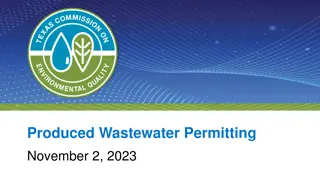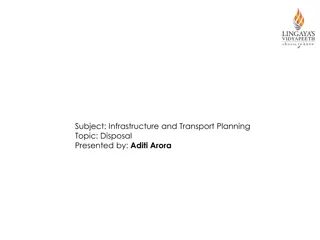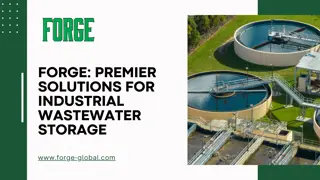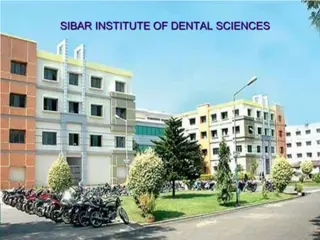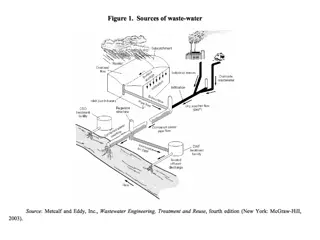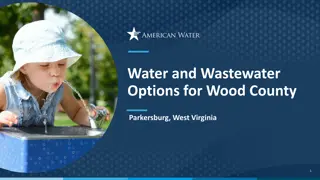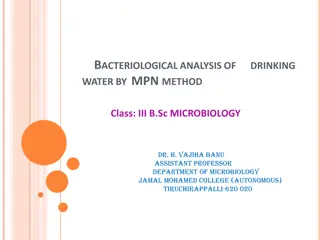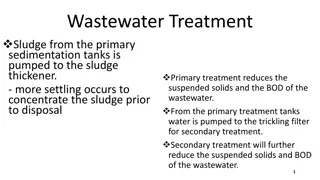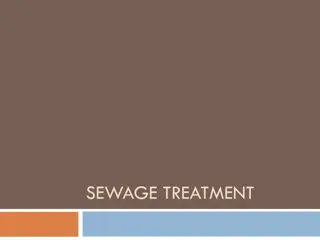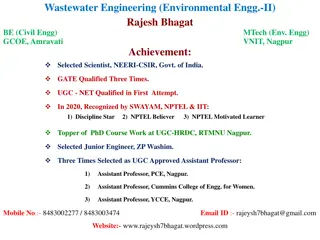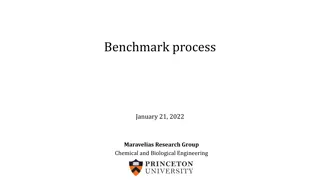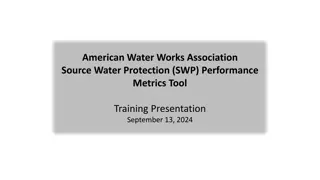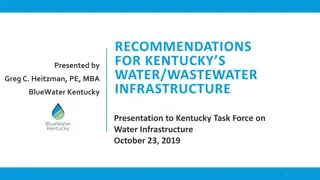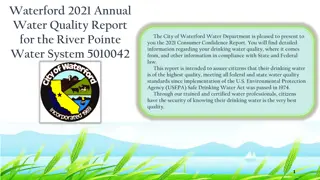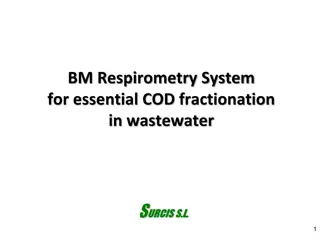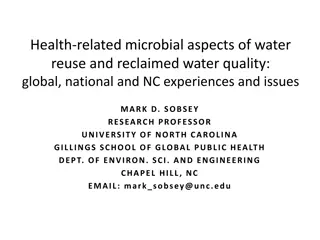Challenges in Temba Drinking Water and Rooiwal Wastewater Treatment Works
The City of Tshwane's Water Services Authority faces significant challenges with the operation and quality of effluent at the Rooiwal Wastewater Treatment Works and the Temba Water Treatment Works. Issues include overcapacity, poor sludge management, non-compliant effluent, and inability to treat water to required drinking standards. Despite some upgrades, these facilities continue to struggle with operational and aesthetic risks, impacting downstream water users and the community at large.
Download Presentation

Please find below an Image/Link to download the presentation.
The content on the website is provided AS IS for your information and personal use only. It may not be sold, licensed, or shared on other websites without obtaining consent from the author. Download presentation by click this link. If you encounter any issues during the download, it is possible that the publisher has removed the file from their server.
E N D
Presentation Transcript
PRESENTATION TITLE STATUS OF TEMBA DRINKING WATER AND ROOIWAL WASTEWATER TREATMENT WORKS Presented by: Name Surname Directorate Presented by: Mr. S Notoane / Mr. S Maphangula Date 16 November 2021
Outline Introduction Background Rooiwal WWTW Temba WTW Portfolio Committee directive Progress report Implementation of the action plan SAHRC report and recommendations Conclusions 2
Introduction The City of Tshwane (CoT) is a Water Services Authority (WSA), which operates various Wastewater and Water Treatment Works within their area of operation. The operation includes the Rooiwaal WWTW and Temba WTW which are located within the Apies River sub-catchment which lies in the northern part of the Pretoria and flows towards the Hammanskraal Town. Rooiwal WWTW was visited and found to be over capacitated and evidently poorly operated and maintained. These conditions have resulted in poor quality effluent being discharged into the Apies River which flows into the Leeukraal Dam. The wastewater effluent quality is non-compliant to the effluent standards. Temba WTW abstracts raw water from the Leeukraal Dam after which it is treated and supplied to communities of Hammanskraal.
BACKGROUND INFORMATION The WWTW is currently not operating optimally due to the following: Plant operating above design capacity The WWTW cannot handle and manage the produced sludge Inadequate and partial treated effluent Poor sludge treatment and handling. The challenges indicated have an adverse impact on downstream water users such as agricultural and domestic sectors Since 2011, there has been recurring overflowing of sludge from the lagoons (maturation ponds) as well as poor quality effluent discharged into the Apies River The Department of Water and Sanitation (DWS) issued the CoT with a Notice and a Directive in terms of Section 19 of the National Water Act, 1998 (Act No. 36 of 1998) [the Act]. Several meetings were held to try and address these challenges with no success DWS approached the court to seek relief.
BACKGROUND INFORMATION - Temba Water Treatment Works Temba WTP abstracts raw water from Leeukraal dam into which Apies river flows Before upgrading of works: DWS has been assessing the drinking water quality results for Temba WTW and the point of use; non-compliance with colour, taste and odour , nitrates, disinfectant and turbidity has been reoccurring After upgrading of works: Temba WTP upgrading has been completed, however due to the quality of raw water, the WTP is unable to treat water to required drinking water standards It should be noted that all parameters that pose a chronic health risk to human beings were compliant with SANS 241. The non compliances are on aesthetic and operational risks
BACKGROUND INFORMATION - Temba Water Treatment Plant DWS has been receiving complaints regarding the quality of drinking water at Hammanskraal . In 2018, the community reported the matter the South African Human Rights Commission (SAHRC). Engagements between SAHRC, CoT and DWS were then held
BACKGROUND INFORMATION - Temba WTP During the Deputy Minister, Mr. D. Mahlobo s visit on 20 August 2019, CoT promised to attend to Biological Nutrient Removal (BNR) unit at Rooiwaal WWTWs. The operation of the unit will reduce the challenges at Temba WTWs. The CoT also indicated that they will increase water tankering until such time that water will be fit for human consumption. Regular meetings for tracking progress of implementation of action plan were held.
Background: Rooiwal wastewater treatment works (cont.) The plant is currently not operating optimally due to the following: The plant is operating above design capacity due to the hydraulic and organic overload Due to the capacity constraints, the plant cannot handle and manage the produced sludge Inadequate and partial treated effluent is discharged. Poor sludge treatment and handling due to capacity constraints. The challenges indicated have an adverse impact on downstream water users such as agricultural and domestic sectors 8
Background: Temba WTP Before the plant upgrades: Temba WTW abstract raw water from Leeuwkraal dam into which Apies river flows Before upgrading of works: DWS has been assessing the drinking water quality results for Temba WTW and the point of use; non-compliance on colour, taste and odour have been observed After upgrading of the plant: Temba WTW upgrading has been completed however due to the quality of raw water, the WTW is unable to treat water to required drinking water standards. However it must be noted that all the parameters that pose a chronic health risk to human beings were compliant with SANS 241. The non compliances are on aesthetic and operational risks 9
Background: Temba water treatment works (cont.) DWS has been receiving complaints regarding the quality of drinking water at Hammanskraal . In 2018, the community finally also reported the matter the South African Human Rights Commission (SAHRC). This led to the start of engagements between SAHRC, CoT and DWS . 10
Portfolio Committee directive During the portfolio committee meeting that was held on 30 August 2019, the Portfolio Committee recommended the CoT to do the following after observing the dire state of affairs: The CoT within 24 hours source chlorine and ensure that effluent is treated and provides the Department with a progress report. The City attended to the chlorine dosing station immediately to ensure that it is operational. DWS visited the plant and confirmed that the matter was resolved. Consider appointing Water Services Providers to perform the operation and maintenance function for both Rooiwal WWTW and Temba WTW. The Water Services Provider could be appointed for a short term to stabilise the plants thus giving the CoT opportunity to recruit key personnel to properly operate and maintain the plants. The City has engaged with both Magalies and ERWAT for collaboration on water and waste water treatment plants. MoU s have been finalised and the appointments are currently being finalised. 11
Portfolio Committee directive (cont.) Do detailed assessments and a plan of the challenges and solutions including funding at the Rooiwaal WWTW and Temba water purification plant. Develop an integrated intervention plan that will address the Rooiwaal, the Apies River, the Leeuwkraal Dam and finally the Temba Water purification works. The Action Plan was developed and tabled to the Committee on 10 September 2020 The CoT is advised to reprioritise its budget including the grants to fund the urgent upgrades and needed O&M including the appointment of Water Service Providers. In the Urban Settlement Development Grant (USDG) Municipal quarterly review meeting held on the 15 August 2019, Department of Human Settlement; Water and Sanitation directed the CoT to reprioritise its USDG allocation to sort out the Hammanskraal water situation as well as the Rooiwal WWTW emergency. 12
Portfolio Committee directive (cont.) Urgently address the security situation at all the key water and sanitation infrastructure. Ensure that all residents of Hammanskraal are supplied with potable water immediately. Residence of Hammanskraal are engaged immediately on sources of portable water being supplied to them, CoT to supply residence with a schedule of water supply with water tankers as per CoT report to the Portfolio Committee, ensure that the tanked water is free (monetary and otherwise), establish monitoring mechanism to ensure quality assurance and mechanism to address challenges where they occur. 13
Progress report: subsequent to engagements with Portfolio Committee ERWAT and Magalies Water were engaged by COT for collaboration in the operation of Temba WTW and Rooiwaal WWTW Memorandum of understanding (MoU) and Service Level Agreements (SLA) have been finalized and the progress is as follows: ERWAT MoU and SLA have been finalised. Magalies MoU is finalised; SLA currently being vetted by CoT legal COT has completed budget reprioritization (adjustments) for the Urban Settlement Development Grant (USDG) to allocate funding for the assistance and interventions Temba WTW is operational, however the community of central Hammanskraal will continue to receive drinking water through water tankers until the quality of the water fully complies with drinking water standards 14
PROGRESS REPORT AT ROOIWAL WWTW Intervention Impact Start/End Date Cost Progress Refurbishment of the Sludge Belt Presses Reduces sludge volume Aug - March 2020 R9m+ 65% Refurbishment of the Return Activated Sludge Screw Pumps Prevents failures in the Secondary Settling Tanks October 2019 R240 000 completed Dredging of Maturation Ponds Creates buffering capacity during plant failures; creates tertiary treatment capacity before final disposal into the river Sept 2018 - March 2020 R10m 50% Continuation of Maintenance Plan (planned & unplanned) Continuous plant operation with minimal interruptions On-going throughout the financial year R24m Ongoing Phase 1 of upgrading of the plant (CAPEX) Additional 40 ML/d treatment capacity Oct 2019 Oct 2022 R290m Contractor terminated 15
PROGRESS REPORT: SUBSEQUENT TO ENGAGEMENTS WITH PORTFOLIO COMMITTEE The aesthetic or physical aspect of Rooiwal WWTW s effluent at the maturation ponds has improved since the dredging has started COT has beefed up security at the WWTW and ensured that the people of Hammanskraal are supplied with water immediately The Hammanskraal community has been informed of the challenges that were being experienced at the Temba WTW and the alternative source of supply and its quality, and also the monitoring schedule. Cleaning of reservoirs were completed on the 26-28 September 2019 to improve the water quality Flushing and disinfection of the water network was completed on the 8-9 October 2019 to improve water quality in the distribution network 16
DIRECTIVE OF THE PORTFOLIO COMMITTEE The Portfolio Committee undertook oversight visits to the City of Tshwane in February 2020 and made recommendations to the Department of Water and Sanitation (DWS) and the City of Tshwane (CoT) including that: The CoT should reprioritise its budget including the grants to fund the urgent upgrades and required Operations and Management Water Services Providers be appointed on a short term basis to stabilise the plants thus giving the CoT opportunity to recruit key personnel to properly operate and maintain the plants. The DWS facilitate the procurement of services from its entities (Magalies and Rand Water Board) that could assist CoT should the CoT wish to utilise their services to address this emergency The CoT Develop an integrated intervention plan that will address pollution of the Rooiwaal, the Apies River, the Leeukraal Dam and finally the Temba Water purification works. 17
ROOIWAL WWTW CONSTRUCTION ACTIVITIES SECTION ACTIVITY % Completed Overall progress construction of the PST 74% PST Refurshment of digesters 55% EAST WORKS DIGESTERS Design, procurement and installation of the difussers. BIOREACTORS 37% Design, procurement Installation of belt press 32% SLUDGE DEWATERING Improvement of the inlet works 4% INLET Installation of bypass pipelne 100% BYPASS PIPELINE 18
SITE PHOTOGRAPHS PST construction Cleaning of digesters 19
APIES RIVER The following studies have been completed: Environmental baseline conditions survey. An assessment report. Work on the rehabilitation requirements, delineation, mapping and prioritisation of affected areas has been done. Groundwater monitoring of the boreholes in and around Rooiwal WWTP proposal was approved and sampling was completed. Testing and report was prepared and submitted. Terrestrial Ecology Study Report, Riverine (Aquatic) Ecology Report, Wetlands Assessment Report and Rehabilitation Plan with a baseline for Hydrological and Hydraulic Assessment Report. Compilation of conceptual designs and implementation plans for rehabilitation. Compilation of preliminary designs and rehabilitation plan 20
FINANCIAL MATTERS SERVICE PROVIDER APPOINTMENT VALUE % EXPENDITURE TO DATE CMS.NJR & Blackhead R 253,399,677.64 47% Royal Haskoning DHV (Pty) Ltd R 19,966,383.80 72% Bashumi Engineering & SHEQ Solutions R 2,952,620.00 20% The Implementing Agent (ERWAT) has been appointed at a cost of 5% on the contractor and engineer's fees. 21
IMPLEMENTATION OF CoT ACTION PLAN Impact category 1 projects Project Type of Project Provisional Project Cost Completion period. (years) Upgrade of existing infrastructure. 80 Ml/d extension and sludge facility extension project Minor upgrade of existing infrastructure. Upgrade of existing infrastructure. Upgrade of existing infrastructure. Upgrading of existing infrastructure (mechanical) R 335 million 2 Rooiwal Phase 1 R 2.1 billion 5 Rooiwal Phase 2 R 10 million 2 Daspoort R 68 million 3 Sunderland Ridge Phase 1 R 45 million 1 Baviaanspoort Phase 1 R 52 million 3 Zeekoegat Phase 1 R 3.28 billion Total 22
IMPLEMENTATION OF CoT ACTION PLAN (Cont.) Impact category 1 projects (cont.) Godrich Sandspruit Phase 1 Klipgat Phase 1 10 Ml/d extension project. Upgrade of sludge handling. Upgrading of Mechanical and R 284 million R 53 million R 215 million 4 2 2 Electrical infrastructure due to vandalism and theft. Commissioning of Module 3, 20 R 55 million 2 Temba Ml/d extension. Sludge handling facility Upgrade of existing infrastructure R 43 million R 20 million 2 2 Ekangala Babelegi and upgrade of process to cater for industrial influent. 23
IMPLEMENTATION OF CoT ACTION PLAN (Cont.) Impact category 2 projects Project Type of Project Provisional Project Cost Completion period. (years) 20 Ml/d extension project using alternative technologies on existing site. R 500 million 5 Sunderland Ridge Phase 2 40 Ml/d Extension of WWTW on new adjacent site. R 900 million 5 Baviaanspoort Phase 2 De-bottleneck and tertiary treatment upgrade project for stricter effluent standards. R 364 million 5 Zeekoegat Phase 2 20 Ml/d extension project and sludge handling facility. R 430 million 5 Rietgat Phase 1 33 Ml/d Extension and Upgrade of sludge handling R 340 million 3 Klipgat Phase 2 R 2.534 billion Total 24
IMPLEMENTATION OF CoT ACTION PLAN (Cont.) Impact category 3 projects Project Type of Project Provisional Project Cost Completion period. (years) 50 Ml/d extension project R 850 million 5 Rooiwal Phase 3 Land acquisition R 155 million 2 Sunderland Ridge Phase 3 Sunderland Ridge Phase 3 Hennops River WWTW Refilwe Phase 1 25 Ml/d extension project on new adjacent site New WWTW or bulk sewer project. R 613 million 5 R 700 million 7 2 Ml/d extension project. R 66 million 2 10 Ml/d extension project on new site. 10 Ml/d extension project. R 346 million 5 Refilwe Phase 2 R 272 million 3 Sandspruit Phase 2 33 Ml/d extension. R 387 million 5 Klipgat Phase 3 R 3.389 million Total 25
IMPLEMENTATION OF CoT ACTION PLAN (Cont.) Summary of capital budget requirements for prioritised critical wastewater treatment works Impact Category Total Budget Impact Category 1 R 3.28 billion Impact Category 2 R 2.534 billion Impact Category 3 R 3.389 million TOTAL R9.203 26
IMPLEMENTATION OF CoT ACTION PLAN (Cont.) Operational budget requirements WWTW Human Resources Maintenance Chemicals Total 21 513 185,88 25 910 000 18 587 559,3 66 010 745,18 Rooiwal 13 732 085,61 12 030 000 2 064 732 27 826 817,61 Daspoort 8 071 746,18 10 320 000 15 005 000 2 781 117,5 21 172 863,68 Baviaanspoort 9 508 254,23 4 679 701,5 29 192 955,73 Zeekoegat 6 323 549,4 3 538 125 64 386 9 926 060,4 Rayton 6 675 777,15 4 717 500 85 848 11 479 125,15 Refilwe 3 052 062,25 6 700 000 328 368,6 10 080 430,85 Godrich 2 863 082,72 6 030 000 282 569,86 9 175 652,58 Ekangala 12 044 601,6 15 270 000 5 999 568,88 33 314 170,48 Sunderland Ridge 5 574 500,34 3 973 127,44 8 854 000 1 233 488,3 15 661 988,64 10 243 127.44 Rietgat 6 270 000 689 083,5 Sandspruit 67 133 784.18 56 623 784,18 10 510 000 1 780 656,15 Klipgat 32 037 037.20 19 865 637,20 12 171 400 627 763,5 Temba 24 493 025.20 19 865 637,20 4 470 000 157 388 Babelegi 188 687 031,30 141 796 025 39 362 231,09 369 845 287,4 TOTAL 27
RECOMMENDATIONS FROM THE SAHRC REPORT The South African Human Rights Commission (SAHRC) launched a report titled Gauteng Provincial Inquiry into the sewage pollution of the City of Tshwane s rivers and Roodeplaat dam on 26 October 2021 at Hammanskraal The South African Human Rights Commission made two critical recommendations which affect the department directly namely: The Commission therefore recommends that the situation regarding failing WWTWs in South Africa and its consequent pollution of South Africa s water resources be declared a national disaster, in accordance with the Disaster Management Act (DMA). As an alternative to the declaration of a national disaster the Commission recommends that in terms of section 139(7) of the Constitution and section 63 of the WSA and sections 19 and 63 of the National Water Act (NWA), Cabinet seriously consider taking a decision for to intervene in the running of the CoT. 28
RECOMMENDATIONS FROM THE SAHRC REPORT (Cont.) As part of declaring the situation a national disaster, the Commission recommended establishment of a national water care entity. The Commission further stated that the need for a mechanism which oversees water care in the context of WWTPs from a national level, and which integrates and operates at provincial level is an acute one. At present challenges appear throughout the value chain in the current design from the various national departments through to local government delivery entities. A National Water Care Entity ( entity ) could be a viable and effective response to the challenges, providing a central point, expertise and integration for the proper management of wastewater services in the country. The Commission further acknowledges through its findings that the primary reason for the unacceptable levels of pollution is the failure to manage and maintain existing WWTWs in the CoT over a prolonged period of time. Failures in management which have resulted in a regression in standards of delivery, include poor planning and implementation evidenced by the insufficient number of WWTWs to accommodate the growing population in the CoT. 29
RECOMMENDATIONS FROM THE SAHRC REPORT The Department acknowledges the recommendation which reads as an alternative to the declaration of a national disaster the Commission recommends that in terms of section 139(7) of the Constitution and Section 63 of the Water Services Act (WSA) and Sections 19 and 63 of the National Water Act (NWA), Cabinet seriously consider taking a decision for National Government to intervene in the running of the City of Tshwane Metropolitan Municipality . As part of this recommendation, the Commission further state that the failure to repair and replace the sewerage systems of the Municipality is not only a failure to comply with the water service authorities (WSA), it is a failure of many people over many years to properly run the Municipality, and the department concurs with the South African Human Rights Commission. The Commission proposed that the water and sanitation departments of the City of Tshwane, be taken over by DWS and that such an intervention can also make use of the services of organs of state such as Rand Water, and the Ekurhuleni Water Care Company (ERWAT). 30
DWS RESPONSE TO SAHRC RECOMMENDATIONS The Minister of Water and Sanitation might explore invocation of section 63, subsection 2 of the Water Services Act (WSA), Act 108 of 1997 to intervene in the CoT, in order to take full control of resuscitation of the water services infrastructure into an operational state. The Act as amended states that if a water services authority has not effectively performed any function imposed on it by or under the Act, the Minister may, in consultation with the Minister for Corporative Governance and Traditional Affairs (COGTA), take appropriate steps to bring about the compliance to the function imposed on the water service authority, internal processes are still unfolding in relation to section 63. According to the South African Human Rights Commission, the department and other affected entities by its recommendations have 60 days to respond from the date of the launch which was 26 October 2021 therefore, the department will respond to the Commission s recommendations within the stipulated time. . 31
CRITICAL ISSUES TO NOTE Minister Mchunu has requested COT to reduce five (5) years estimated period to complete 2nd phase of Rooiwal refurbishment/upgrade program to three (3) years. The timelines could be reduced to 4 years (3 years construction + 1 year for designs and environmental approvals) if the project is classified as an emergency and supply chain processes and regulatory requirements be shortened to directly appoint suitable service providers (designers and contractors). Such action will also be subject to immediate availability of funding to ensure immediate implementation. Minister Mchunu has instructed the department to find an interim solution of providing drinking water to affected Hammanskraal communities because completion of Rooiwal 1st phase completion in October 2022 is too far. Rand Water provided assessment report of options to provide water to affected Hammanskraal communities on November 10 2021 and the report is receiving DWS attention. 32
END 33



